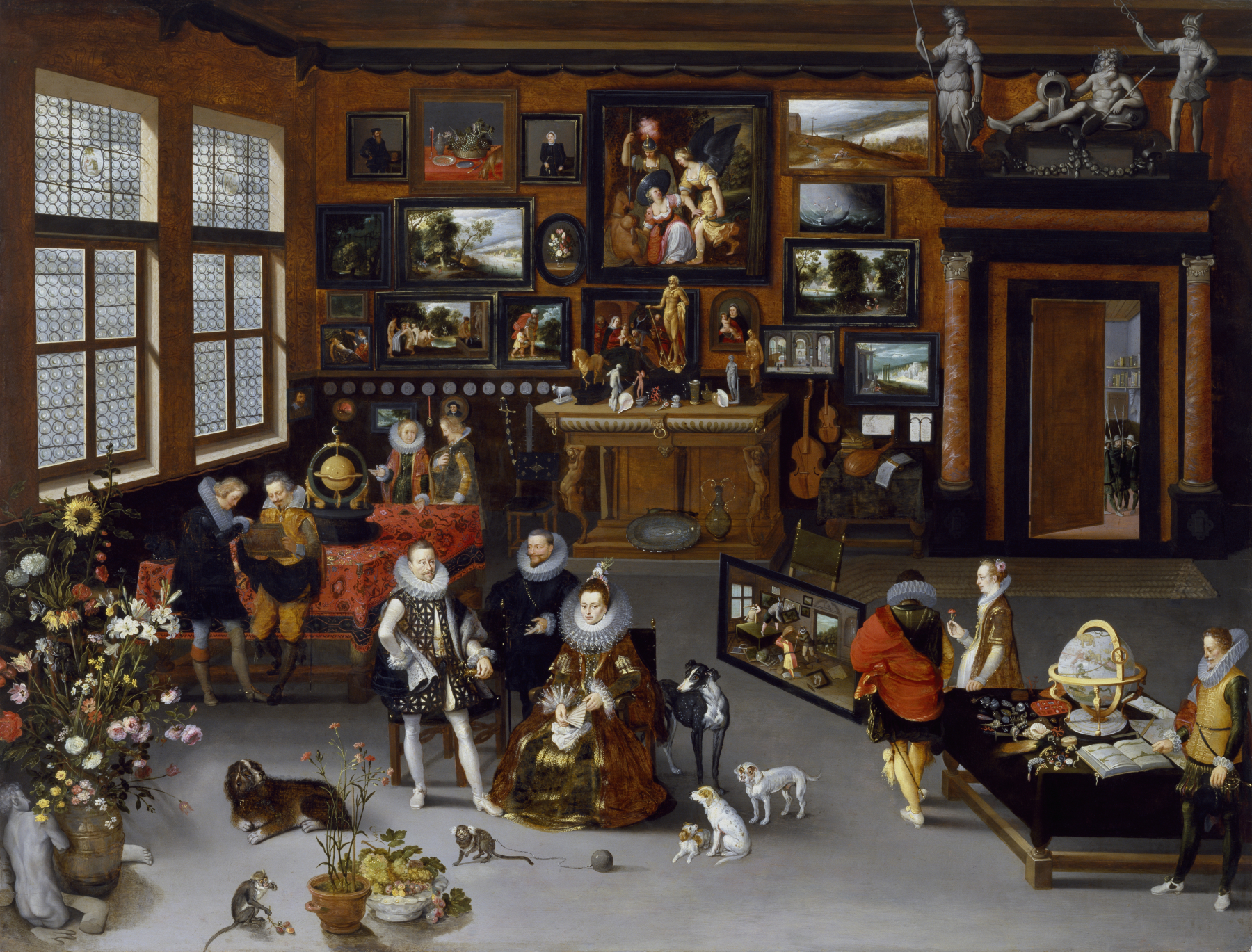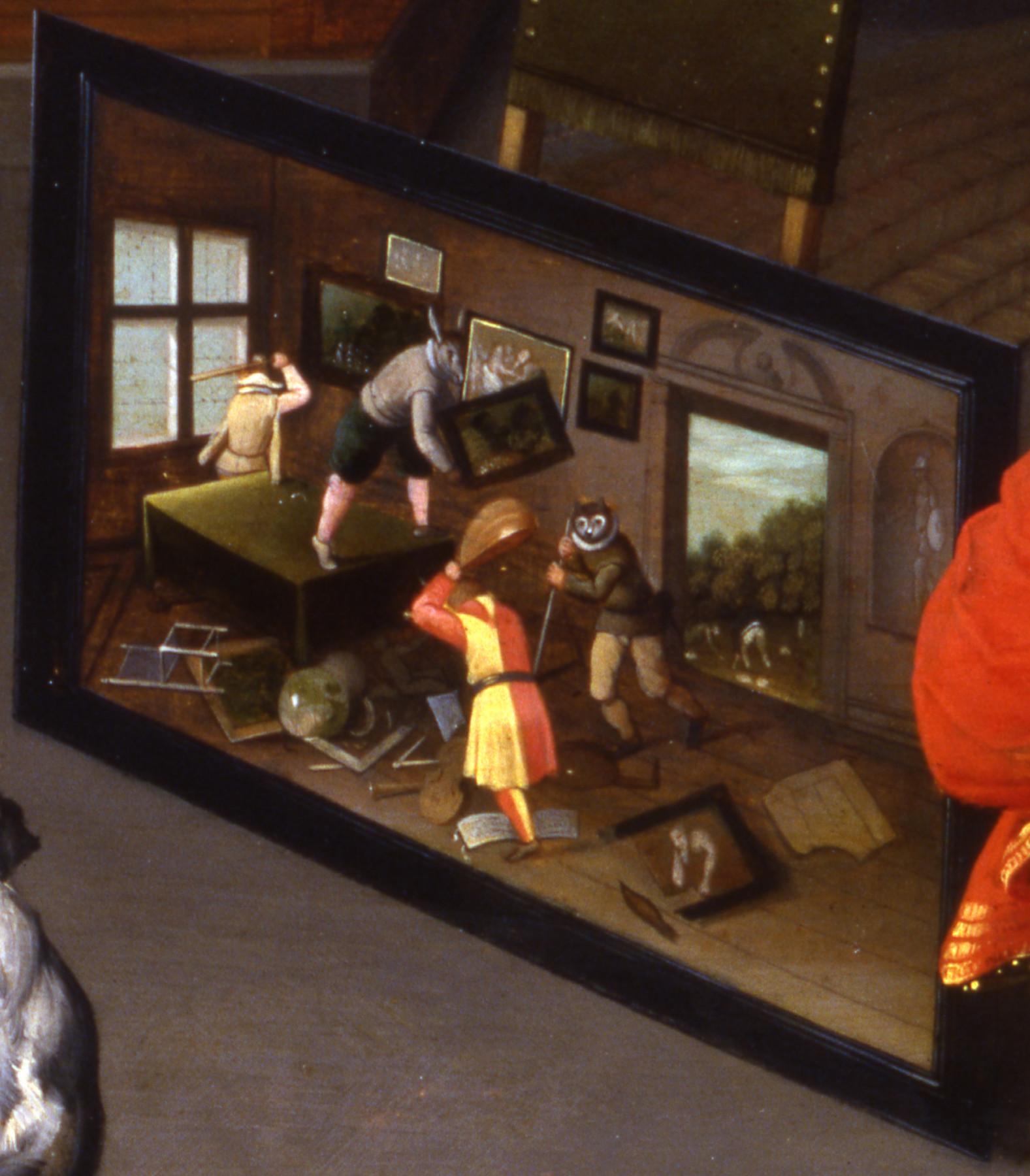The Archdukes Albert and Isabella Visiting the Collection of Pierre Roose
(Baroque Europe )
This painting of a private gallery or cabinet of the Flemish collector and statesman Pierre Roose who lived in Brussels is focused on a visit by Archdukes Albert and Isabella, the Habsburg governors of the Southern Netherlands. Isabella is seated, while her husband stands to her right and their host, Pierre Roose, behind.
The walls are covered with paintings by Flemish artists. The sculpture displayed throughout is from various schools, but includes the bronze "Allegory of Architecture" by Giambologna, a Flemish sculptor who made his fortune in Florence. A painted "Allegory of Iconoclasm," depicting people who destroy art as animals, rests against a chair. Visitors examining paintings and objects on the tables draw the viewer's attention to these objects, as well as shells and a stuffed bird of paradise, from the Spice Islands. Pets include a monkey, kept out of mischief on a chain, and a dog, apparently with two heads (an alteration by the artist that has "bled" through). The globe-like object on the table at the left is one of Cornelis Drebbels' attempts at a perpetual-motion clock; the principles which ran it are now lost.
Depictions of art collections were a specialty of Antwerp painters but very few can be connected to specific collectors. There are symbolic elements of the composition that tie it Roose while Albert's and Isabella's role as rulers and patrons of the arts is also celebrated here, indeed in an unprecedented way. The immense vase of flowers by Jan Brueghel, the greatest Flemish flower painter, is crowned by a large sunflower. This South American flower which could grow to be 14 feet tall and could turn toward the sun, was first seen by Europeans in the mid-1500s. It had been illustrated as a New World wonder in botanical treatises, but this is its earliest inclusion in a painting and its earliest use as a symbol of princely patronage. In turning to the sun (but here toward Albert and Isabella), it symbolizes the way that the arts grow and blossom in the light and warmth of princely patronage.
Inscription
Provenance
Provenance (from the French provenir, 'to come from/forth') is the chronology of the ownership, custody, or location of a historical object. Learn more about provenance at the Walters.
J. P. Morgan [1837-1913], New York [date and mode of acquisition unknown]; L. Satterlee, New York [date and mode of acquisition unknown]; Sale, Parke Bernet Galleries, New York, April 22, 1948, no. 25; Walters Art Museum, 1948, by purchase.
Exhibitions
| 2018 | The Paston Treasure: Microcosm of the Known World. Yale Center for British Art, New Haven; Norwich Castle Museum, Norfolk. |
| 2001-2002 | Devices of Wonder: From the World in a Box to Images on a Screen. J. Paul Getty Museum, Los Angeles. |
| 1998-2001 | Highlights from the Collection. The Walters Art Gallery, Baltimore. |
| 1998 | A Collector's Cabinet. National Gallery of Art, Washington. |
| 1995-1996 | Going for Baroque. The Walters Art Gallery, Baltimore. |
| 1995 | The Allure of Bronze. The Walters Art Gallery, Baltimore. |
| 1980 | Salute to Belgium. The Walters Art Gallery, Baltimore. |
| 1971-1972 | World of Wonder. The Walters Art Gallery, Baltimore. |
Geographies
Belgium, Antwerp (Place of Origin)
Measurements
H: 37 × W: 48 1/2 × D: 1 1/8 in. (94 × 123.19 × 2.86 cm); Framed H: 46 × W: 56 1/2 × D: 3 3/8 in. (116.84 × 143.51 × 8.57 cm)
Credit Line
Museum purchase, 1948
Location in Museum
Accession Number
In libraries, galleries, museums, and archives, an accession number is a unique identifier assigned to each object in the collection.
In libraries, galleries, museums, and archives, an accession number is a unique identifier assigned to each object in the collection.
37.2010




